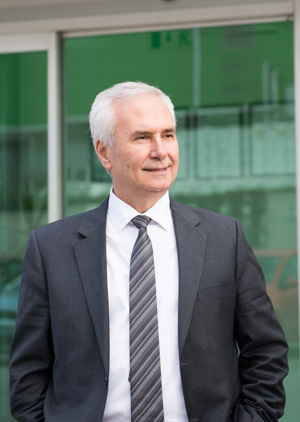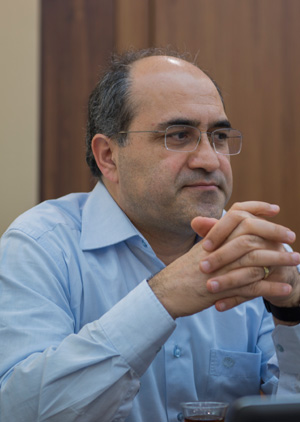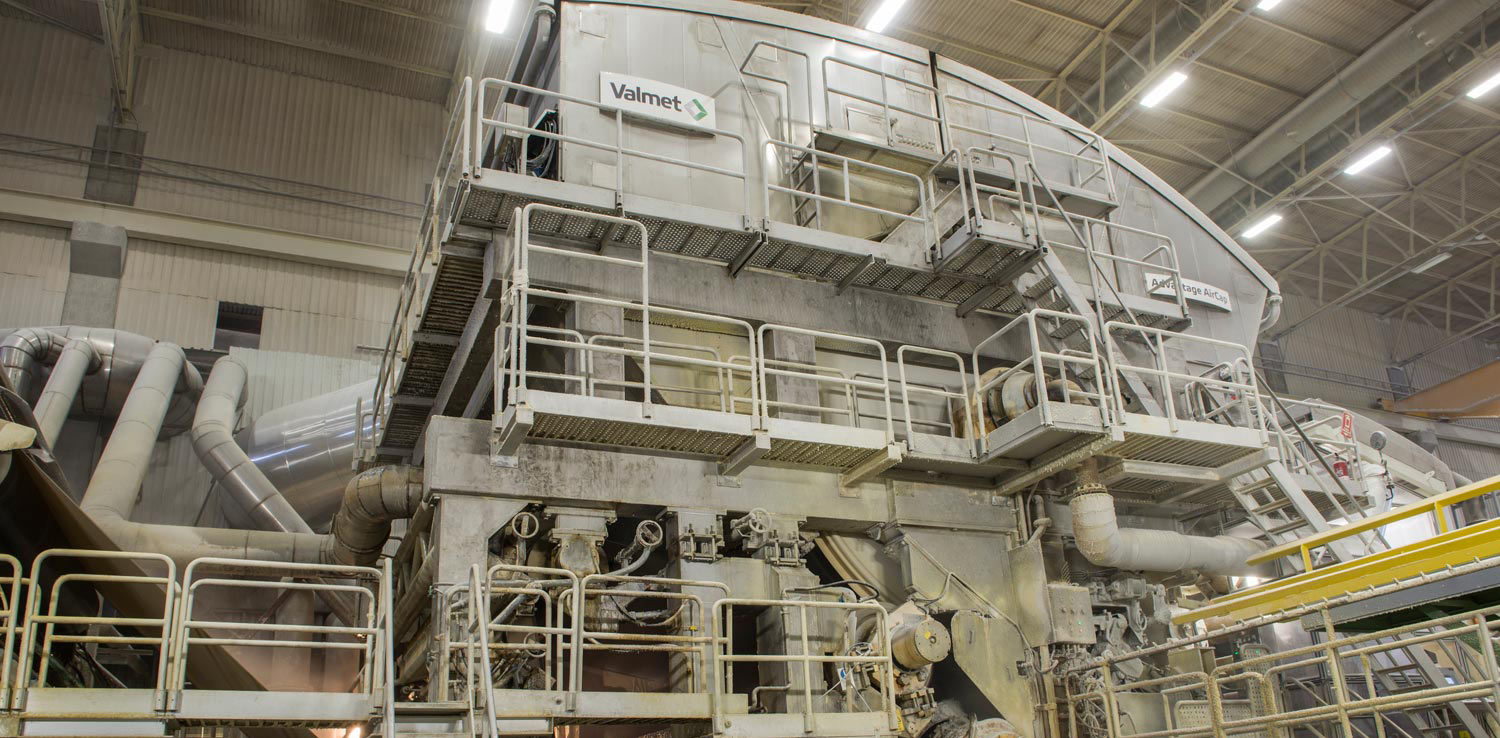To improve production capacity, runnability and energy efficiency they decided to upgrade the machine to the Advantage DCT technology, in line with their other five tissue machines. It was a major rebuild project and a big challenge as it had to be finalized within five weeks. But with thorough planning and systematic work it was finalized in time and the result even exceeded their expectations.
Web breaks are more or less a memory
Summarizing the rebuild of TM1 in Izmit, fulfilled the targets and gave some surprises too. Pretty soon after the start-up they realized that the web breaks are remarkably low, the production capacity increased significantly and the machine is easier to operate.
“Before the rebuild we had a production capacity of 8-9 tons per hour, now we can easily make 10-11 and sometimes even 12 tons per hour. But most remarkable was that the web breaks were more or less eliminated which in turn improved the machine speed” says Lütfi Aydin, Global Paper Group Director.
Today the moisture profiles are optimized and there is no need for a steambox anymore. The improved base paper properties have given effect also in converting machine which now runs at higher speed and with less stops. The drying energy savings are obvious.
“The flexibility in nip load makes it possible to get up to 6% capacity increase with lower energy consumption or keep the same production as earlier with 16% less total energy. But we believe that the Advantage ViscoNip press is the main reason behind most of the improvements. It is indeed the new magic for tissue making” Kemal Arslan, Investment and Project Manager, concludes.


Thorough planning the key for efficient project execution
To bring 100 persons together to work effectively in a narrow space is a big challenge. The time frame was set to 35 working days which turned out to be tough, but doable. “A new installation is easy. A rebuild project, on the other hand, is a very big effort and the planning is difficult as 100 people are involved. All work were planned to be done during daytime. It was very difficult to foresee all kind of situations that can appear so we did many changes” tells Mr. Arslan.
Hayat Kimya has a systematic way to work with tissue machine installations, utilizing the same people and their experiences from previous projects. This turned out to be successful also in this project. Mr. Arslan continues: “We sent our machine operators to TM4 in Russia and TM5 in Mersin, Turkey to learn how to operate the ViscoNip technology, which was new to the people in Izmit. So when the machine started up they already knew how it worked and how to control it. They were also familiar with the mechanical and electrical maintenance, the system and the logics. That was a big advantage”.
The project was finalized according to time schedule and once again the expectations were exceeded. “I was worried we had to spend a long time to reach the same runnability, but in two or three days we were running at the same level as before. That was a positive surprise, our team made a very good job together with Valmet” says Mr. Aydin.
Advantage ViscoNip – The magic device
During the years the mill team had put extra effort to continuously improve the press section. A steambox was installed to correct the profiles, tests were performed with various Yankee crowning, shell material, coatings and felts. But the profiling problems remained.

At the same time they had great experiences of operating the Advantage ViscoNip press in Russia and Mersin which convinced them that it would also be the solution for TM1. “I believe that the ViscoNip press is the new magic unit for tissue makers, a new standard for tissue machines. We have seen many improvements after the rebuild. The profiles are significantly better and have allowed us to increase the moisture level at the reel which has given 1-1,5% production increase. We have almost no paper breaks and the even dryness on the edges creates a lot of advantages”, Mr. Arslan reveals.
…also improving converting efficiency
Several trials have been done with different nip load to test how different loads are affecting energy consumption and product quality. Energy savings up to 16% are common with high nip load while quality improvements like higher strength and surface softness can be achieved with lower load.
I believe that the ViscoNip press is the new magic unit for tissue makers, a new standard for tissue machines
But the ViscoNip also affect the converting side. One of the biggest challenges is to optimize the paper production for best quality and energy efficiency in converting side. Mr. Arslan continues: “We have seen a capacity increase of 5-8 percent in converting. One reason is the base paper, as better quality enhances the embossing and the converting machine can run at higher speeds. With high quality paper you can also run the machine with less stops. This also effects efficiency of course”.
New Helical design of Advantage AirCap
The old Yankee hood was not in very good shape. It was mechanically instable and neither air circulation nor profile fulfilled the requirements. The new hood on the other hand has a brand new design where the headers are tilted in cross machine direction which allows very even drying profiles. “To compare the results from the new hood with the old we tried to create the same conditions as we had in the old hood with same press load producing the same product and we found an increase of 7% in hood efficiency. Previously we had big temperature variations on the Yankee surface. The Helical hood has no such thing”.
Cogen upgrade to familiar design
The upgrade of the web stabilizer, dust removal system and cogeneration system to Valmet design did not only improve general efficiency, it also save time. Instead of dealing with problems the machine operators can now concentrate on running the machine, produce best quality paper and contribute to the total efficiency. “The new cogeneration system makes it possible to generate steam even when the machine has stopped. It has also raised the exhaust temperature about 20 degrees which gave two extra tons of steam. We also save 70 tons of water as we need less fresh water for the boilers”.
We have almost no paper breaks and the even dryness on the edges creates a lot of advantages
Hayat Kimya decided to enter the tissue business in 2004 and their first tissue machine started up at the Izmit mill in 2006. Two years later the production capacity hit the limit. At the same time the market demand was steadily growing. So TM1 was followed by TM2, an Advantage DCT tissue machine from Valmet and the company started to grow rapidly.
Today Hayat Kimya has six tissue machines in operation, in four countries, with an annual capacity of 420.000 tons of tissue paper and a capacity to convert 290.000 tons of consumer products.


Valmet
Valmet is the leading global developer and supplier of technologies, automation and services for the pulp, paper and energy industries. Valmet’s vision is to become the global champion in serving its customers. Our 12,000 professionals around the world work close to our customers and are committed to moving our customers’ performance forward – every day.
Valmet’s services cover everything from maintenance outsourcing to mill and plant improvements and spare parts. The strong technology offering includes pulp mills, tissue, board and paper production lines, as well as power plants for bio-energy production. Valmet’s advanced automation solutions range from single measurements to mill wide turnkey automation projects.
To improve production capacity, runnability and energy efficiency they decided to upgrade the machine to the Advantage DCT technology, in line with their other five tissue machines. It was a major rebuild project and a big challenge as it had to be finalized within five weeks. But with thorough planning and systematic work it was finalized in time and the result even exceeded their expectations.
Web breaks are more or less a memory
Summarizing the rebuild of TM1 in Izmit, fulfilled the targets and gave some surprises too. Pretty soon after the start-up they realized that the web breaks are remarkably low, the production capacity increased significantly and the machine is easier to operate.
“Before the rebuild we had a production capacity of 8-9 tons per hour, now we can easily make 10-11 and sometimes even 12 tons per hour. But most remarkable was that the web breaks were more or less eliminated which in turn improved the machine speed” says Lütfi Aydin, Global Paper Group Director.
Today the moisture profiles are optimized and there is no need for a steambox anymore. The improved base paper properties have given effect also in converting machine which now runs at higher speed and with less stops. The drying energy savings are obvious.
“The flexibility in nip load makes it possible to get up to 6% capacity increase with lower energy consumption or keep the same production as earlier with 16% less total energy. But we believe that the Advantage ViscoNip press is the main reason behind most of the improvements. It is indeed the new magic for tissue making” Kemal Arslan, Investment and Project Manager, concludes.


Thorough planning the key for efficient project execution
To bring 100 persons together to work effectively in a narrow space is a big challenge. The time frame was set to 35 working days which turned out to be tough, but doable. “A new installation is easy. A rebuild project, on the other hand, is a very big effort and the planning is difficult as 100 people are involved. All work were planned to be done during daytime. It was very difficult to foresee all kind of situations that can appear so we did many changes” tells Mr. Arslan.
Hayat Kimya has a systematic way to work with tissue machine installations, utilizing the same people and their experiences from previous projects. This turned out to be successful also in this project. Mr. Arslan continues: “We sent our machine operators to TM4 in Russia and TM5 in Mersin, Turkey to learn how to operate the ViscoNip technology, which was new to the people in Izmit. So when the machine started up they already knew how it worked and how to control it. They were also familiar with the mechanical and electrical maintenance, the system and the logics. That was a big advantage”.
The project was finalized according to time schedule and once again the expectations were exceeded. “I was worried we had to spend a long time to reach the same runnability, but in two or three days we were running at the same level as before. That was a positive surprise, our team made a very good job together with Valmet” says Mr. Aydin.
Advantage ViscoNip – The magic device
During the years the mill team had put extra effort to continuously improve the press section. A steambox was installed to correct the profiles, tests were performed with various Yankee crowning, shell material, coatings and felts. But the profiling problems remained.

At the same time they had great experiences of operating the Advantage ViscoNip press in Russia and Mersin which convinced them that it would also be the solution for TM1. “I believe that the ViscoNip press is the new magic unit for tissue makers, a new standard for tissue machines. We have seen many improvements after the rebuild. The profiles are significantly better and have allowed us to increase the moisture level at the reel which has given 1-1,5% production increase. We have almost no paper breaks and the even dryness on the edges creates a lot of advantages”, Mr. Arslan reveals.
…also improving converting efficiency
Several trials have been done with different nip load to test how different loads are affecting energy consumption and product quality. Energy savings up to 16% are common with high nip load while quality improvements like higher strength and surface softness can be achieved with lower load.
I believe that the ViscoNip press is the new magic unit for tissue makers, a new standard for tissue machines
But the ViscoNip also affect the converting side. One of the biggest challenges is to optimize the paper production for best quality and energy efficiency in converting side. Mr. Arslan continues: “We have seen a capacity increase of 5-8 percent in converting. One reason is the base paper, as better quality enhances the embossing and the converting machine can run at higher speeds. With high quality paper you can also run the machine with less stops. This also effects efficiency of course”.
New Helical design of Advantage AirCap
The old Yankee hood was not in very good shape. It was mechanically instable and neither air circulation nor profile fulfilled the requirements. The new hood on the other hand has a brand new design where the headers are tilted in cross machine direction which allows very even drying profiles. “To compare the results from the new hood with the old we tried to create the same conditions as we had in the old hood with same press load producing the same product and we found an increase of 7% in hood efficiency. Previously we had big temperature variations on the Yankee surface. The Helical hood has no such thing”.
Cogen upgrade to familiar design
The upgrade of the web stabilizer, dust removal system and cogeneration system to Valmet design did not only improve general efficiency, it also save time. Instead of dealing with problems the machine operators can now concentrate on running the machine, produce best quality paper and contribute to the total efficiency. “The new cogeneration system makes it possible to generate steam even when the machine has stopped. It has also raised the exhaust temperature about 20 degrees which gave two extra tons of steam. We also save 70 tons of water as we need less fresh water for the boilers”.
We have almost no paper breaks and the even dryness on the edges creates a lot of advantages
Hayat Kimya decided to enter the tissue business in 2004 and their first tissue machine started up at the Izmit mill in 2006. Two years later the production capacity hit the limit. At the same time the market demand was steadily growing. So TM1 was followed by TM2, an Advantage DCT tissue machine from Valmet and the company started to grow rapidly.
Today Hayat Kimya has six tissue machines in operation, in four countries, with an annual capacity of 420.000 tons of tissue paper and a capacity to convert 290.000 tons of consumer products.

Products
Paper machines, Paper Mills plants, Paperboard machines, Production lines.



